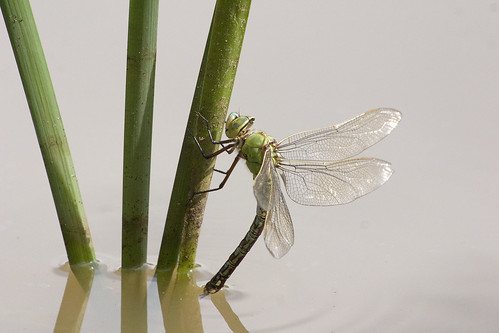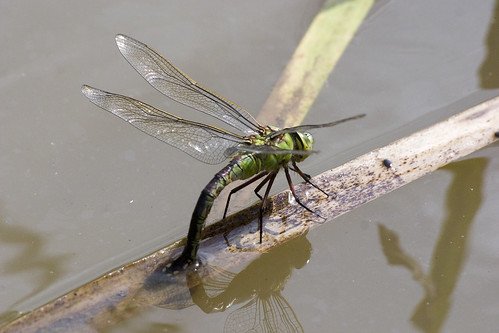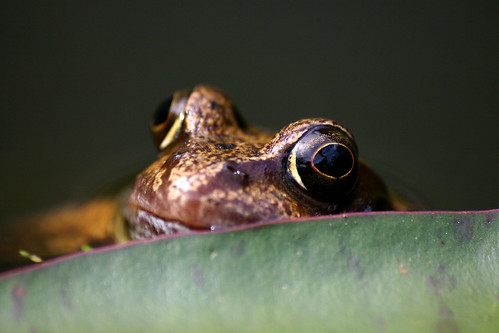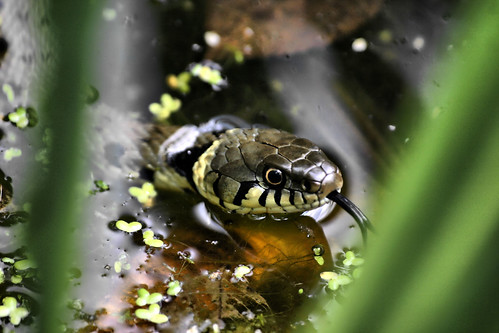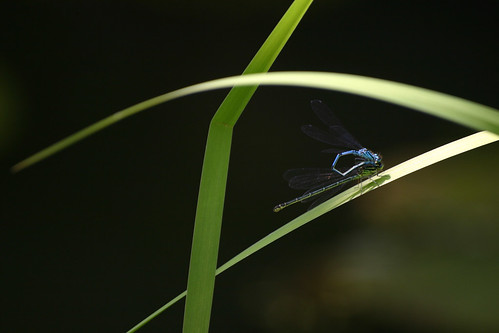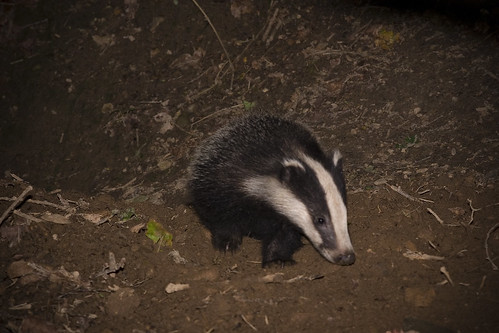Not being venomous, the snake's only defence is to produce a foul-smelling fluid (containing asafoetida) from the anal glands (I sense a theme developing in this evening's pictures) and/or feigning death by becoming completely limp. Rarely, they may also perform fake attacks, striking without actually opening their mouths. They bite in defense rarely.
http://en.wikipedia.org/wiki/Grass_snake
Grass Snake, Forest of Dean
Dragonfly, Forest of Dean
Taken at Plump Hill pond. There was a large number of dragonfly today - laying eggs, mating, and flying in random directions determined to avoid photographs of themselves in flight.
http://en.wikipedia.org/wiki/Dragonfly
Tiny bridge, Forest of Dean
These large stones form a bridge over a trickle of a stream on Plump Hill. The path is very close to Fairplay Mine, so I guess it was once a tramway. Loads of info and a map at http://www.gsia.org.uk/reprints/1980/gi198003.pdf (note, it's a PDF document).
Dragonfly, Forest of Dean
Female dragonfly lay eggs in or near water, often on floating or emergent plants. When laying eggs, some species will submerge themselves completely in order to lay their eggs on a good surface. The eggs then hatch into nymphs. Most of a dragonfly's life is spent in the naiad (that is, nymph) form, beneath the water's surface, using extendable jaws to catch other invertebrates or even vertebrates such as tadpoles, fish, etc. They breathe through gills in their rectum, and can rapidly propel themselves by suddenly expelling water through the anus.
I'm not making this up! check Wikipedia...
http://en.wikipedia.org/wiki/Dragonfly
Radio Mast 2
I think this mast is owned by BT. Another two have just gone up for the benefit of GCHQ. Who knows what they're for. Shame that with all this technology so close, we can't even get a decent internet connection! Still, at least we're promised 2Mbit by 2012... gee, thanks Gordon!
Frog
I'd really like to get a close up of just the eye, but I'd need a different lens for that.
http://en.wikipedia.org/wiki/Frog
Frog
This one was a pretty willing subject, but he was too chilled out to bother with any more poses for the camera.
http://en.wikipedia.org/wiki/Frog
Grass Snake, Forest of Dean
Grass Snakes are strong swimmers and may be found close to fresh water, although there is evidence that individual snakes often do not make use of water bodies throughout the entire season.
The preferred habitat appears to be open woodland and 'edge' habitat such as field margins and woodland borders as these may offer adequate refuge while still affording ample opportunity for basking activity and thermoregulation. Pond edges are also favoured and the relatively high chance of observing this secretive species in such areas may account for their perceived association with ponds and water.
http://en.wikipedia.org/wiki/Grass_snake
X-Rated Damselfly
Damselflies undergo incomplete metamorphosis, with an aquatic nymphal stage. The female lays eggs in water, sometimes in underwater vegetation, or high in trees in bromeliads and other water-filled cavities. Nymphs are carnivorous, feeding on daphnia, mosquito larvae, and various other small aquatic organisms. The gills of damselfly nymphs are large and external, resembling three fins at the end of the abdomen. After moulting several times, the winged adult emerges and eats flies, mosquitoes, and other small insects. Some of the larger tropical species are known to feed on spiders, hovering near the web and plucking the spider from its nest.
http://en.wikipedia.org/wiki/Damselfly
Damselfly
The Damselfly (Suborder Zygoptera) is an insect in the Order Odonata. Damselflies are similar to dragonflies, but the adults can be differentiated by the fact that the wings of most damselflies are held along, and parallel to, the body when at rest. Furthermore, the hindwing of the damselfly is essentially similar to the forewing, while the hindwing of the dragonfly broadens near the base, caudal to the connecting point at the body. Damselflies are also usually smaller, weaker fliers than dragonflies, and their eyes are separated.
http://en.wikipedia.org/wiki/Damselfly
Wild boar
Taken at the same time as the last batch of wild boar photos, but only uploaded now. Wish my Photoshop skills were better, so that I could remove the yellow/pink effect in the eyes from the flash. In humans its easy - just click the anti-redeye button and you're done :)
Badger
After two hours of not moving or making a sound (I was dying to cough!), aching legs, and a couple of visits from passing deer, this badger emerged from the set. The tunnel entrance is to the left of the picture. In retrospect, I should have given the badger a bit more time, and perhaps waited to see if more would follow before taking the shot. Focus isn't as good as I'd have liked, but it's too dark to see very well, so it's something of a 'best guess'.
Dor Beetle
Whilst on my way to watch badgers this evening, this little chap narrowly avoided my boot.
Deer, Forest of Dean
Fallow deer can regularly be seen roaming through the woodlands of the Forest of Dean. There are approximately 400 deer in the forest.
Forestry Commission link
Triple rainbow
There was also a much wider rainbow surrounding this one, but I couldn't get them both in shot with the lens I had with me. The inner one was unusual enough to take a pic of though, with the extra bands of colour.
Wild Boar (Sus Scrofa)
Between their medieval extinction and the 1980s, when wild boar farming began, only a handful of captive wild boar, imported from the continent, were present in Britain. The Herefordshire/Gloucestershire population, which is based in the Forest of Dean, originates from one escape of boar of Eastern European origin in 1997 from a farm near Weston under Penyard and another apparently deliberate release near Staunton in 2004 and together now form probably the largest single population in the UK with a total population well in excess of 200 with groups of over 30 having been seen and photographed in several different locations in the forest. http://en.wikipedia.org/wiki/Wild_boar
Finally it's starting to feel like all the persistence, mud, midges, heat, cold, etc is paying off :)
Wild Boar (Sus Scrofa)
The wild boar (Sus scrofa) or wild hog, colloquially referred to as "the Boar," is a species of a pig in the biological family Suidae and the wild ancestor of the domestic pig. It is native across much of Central Europe, the Mediterranean Region (including North Africa's Atlas Mountains) and much of Asia as far south as Indonesia, and has been introduced elsewhere.
Although common in France, the wild boar became extinct in Great Britain and Ireland by the 17th century, but wild breeding populations have recently returned in some areas, particularly the Weald, following escapes from boar farms.
http://en.wikipedia.org/wiki/Wild_boar
Not sure how the 'blob' ended up there, but I don't think it detracts too much from the rest of the image.
Wild Boar (Sus Scrofa)
The term boar is used to denote an adult male of certain species—including, confusingly, domestic pigs. However, for wild boar, it applies to the whole species, including, for instance, "sow wild boar" or "wild boar piglet"
http://en.wikipedia.org/wiki/Wild_boar
Wild Boar (Sus Scrofa)
The animals are usually nocturnal, foraging from dusk until dawn but with resting periods during both night and day. They eat almost anything they come across, including grass, nuts, berries, carrion, roots, tubers, refuse, insects, small reptiles—even young deer and lambs (carrion only)
http://en.wikipedia.org/wiki/Wild_boar
Wild Boar (Sus Scrofa)
The Herefordshire/Gloucestershire population, which is based in the Forest of Dean, originates from one escape of boar of Eastern European origin in 1997 from a farm near Weston under Penyard and another apparently deliberate release near Staunton in 2004 and together now form probably the largest single population in the UK with a total population well in excess of 200 with groups of over 30 having been seen and photographed in several different locations in the forest.
http://en.wikipedia.org/wiki/Wild_boar
Having a good root about. I watched as it dug up the tree stump and tossed it aside with ease to dig about beneath it.
Wild Boar (Sus Scrofa)
In recent centuries, the range of wild boar changed dramatically because of hunting by humans. They probably became extinct in Great Britain in the 13th century: certainly none remained in southern England by 1610, when King James I reintroduced them to Windsor Great Park. This attempt failed due to poaching, and later attempts met the same fate. By 1700 there were no wild boar remaining in Britain.
http://en.wikipedia.org/wiki/Wild_boar
Beneath this trees it was pretty much impossible to see the boar with the naked eye. All I had to go on was the sound, and a bit of luck with the manual focus. It would be nice to be able to take some daylight shots, but the boar are increasingly nocturnal, which is probably a good thing, photography aside.
Wild Boar (Sus Scrofa)
I got a little closer to this one than I'd have liked, particularly as he was a pretty big one. The pictures (as usual) were difficult due to circumstance, poor light, feeling of urgency, etc. Once I'd taken these shots I left him pretty quickly to continue doing his thing. I'd scared him off once when he first spotted me, but he was quite quick to return and this time was standing his ground while letting out a deep and long rumble/growl. I took the hint....
Forest Sunset
Taken after a successful evening watching wild boar and deer. I almost managed to get a nice photo of a fox in the daylight, but the fox was scared off by a deer - makes a change from me I suppose!

